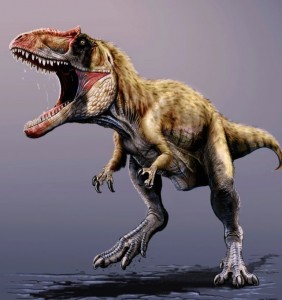
A new, 4-ton, 30-foot dinosaur has been unearthed in the Utah Cedar Mountains and the carnivor may have been the top predator 98 million years ago.
The species was named “Siats Meekerorum,” borrowing the term siats from the Ute language which mean ferocious monster. The carnivore was a theropod like the tyrannosaurus rex and lived during the middle of the Cretaceous period, some time before the t-rex.
Brooks Britt is an geologist scientist and professor at the BYU Museum of Paleontology. He said the bones found were a great specimen.
“The bones were very well preserved and from a time we didn’t know very much about,” Britt said. “When bones like this are analyzed, we establish a better estimate of prehistoric life.”
Several black bones of a vertebrate, parts of the hip, the lower leg, and toes and other pieces were discovered by Lindsay Zanno of North Carolina State University and Peter Makovicky of Chicago’s Field Museum of Natural History. The scientist are among many that are drawn to Utah to excavate bones.
“Utah is one of the greatest dinosaur bone hunting grounds on the planet,” said Dan Chure, a paleontologist from the Utah Dinosaur National Monument. “The desert terrain is ideal of excavating because lots of erosion has taken place and bones have been preserved well.”
Brooks said scientists are frequently drawn to Utah looking for bones.
“They’re always here looking,” Brooks said. “Utah wasn’t always a desert, and many dinosaurs used to live here. Now due to erosion, rocks are the right age and there is minimal vegetation leaving evidence of bones right at our feet.”
The newly discovered dinosaur was dated back to time where few other fossils have been found. The find gives a good idea of what the world was like 98 million years ago.
“Discoveries like this and other recently announced discoveries show that even though a great deal of field work has been done, there is still a great deal to be discovered,” Chure said.
Students at BYU have a unique opportunity to work in the field with their professors, as well as at the BYU Paleontology museum. Freshman Jenny Bowers said that a recent visit to the museum and hearing about the sits meekerorum discovery had re-sparked her interest in paleontology.
“I went on a tour at the museum with my class and see behind the scenes of clean and caring for bones.” Bowers said. “It reminded me of when I was little and wanted to be a dinosaur scientist, and now I realize I really can do that.”
New dinosaur species are being discovered quite frequently across the world.
“Globally there is a new species discovered maybe every 2-3 weeks,” Chure said. “And eight or nine new species were discovered in just Utah in last year. And there are many more existing species uncovered quite frequently.”
Although only a few bones were discovered, scientist are able to determine how the dinosaur may have looked and behaved. Paleontologist are able to determine bone structure and types of dinosaurs from just a few bone characteristics.
“It’s like how some people can see a grill of a car and tell you what make it is,” Chure said. “Different skeletal bones have unique shapes and sizes, and we are able to recognize the dinosaur type from previous discoveries and analysis.”
Other theopods have been discovered with feather preservations, and so scientist can infer that the siats meekerorum probably was feathered and was similar in features to the tyrannosaurus rex, but with definite differential characteristics from the famous predator. The most recognizable different trait would be longer arms on the siats meekerorum.
As technology has advanced, better analysis has been performed. Communication has improved between paleontologists so specimen can be studied easier.
“We now have ways of scanning bones that are too delicate to be removed,” Chure said. “With technology you can basically walk through the rock without disturbing anything.”




